5 Healthy Vegetable Side Dishes for Thanksgiving
Looking for healthy vegetable side dishes for Thanksgiving that actually taste amazing? You’re in the right place! This year, transform your holiday table with vibrant, nutritious sides that don’t sacrifice flavor for health. These veggie-packed dishes are bursting with seasonal goodness, easy to prepare, and will have even picky eaters coming back for seconds.
Whether you’re hosting a crowd or bringing a dish to share, these recipes prove that healthy can be absolutely delicious. Just like our popular Herb-Roasted Turkey Breast, these sides celebrate fresh ingredients and simple preparation that lets natural flavors shine.
What Are Healthy Vegetable Side Dishes for Thanksgiving?
Ever wonder why vegetables always play second fiddle at Thanksgiving? Well, not this year! Healthy vegetable side dishes for Thanksgiving are colorful, nutrient-rich preparations that complement your main course without weighing you down.
Think roasted Brussels sprouts with crispy edges, caramelized carrots glazed to perfection, or green beans that actually taste like something special. These aren’t your grandmother’s mushy vegetables. They’re vibrant, flavorful, and prove that the way to anyone’s heart is through creative, delicious cooking. Ready to make vegetables the star of your Thanksgiving table?
Why You’ll Love These Healthy Vegetable Side Dishes for Thanksgiving
Nutrient-Dense and Delicious
These healthy vegetable side dishes for Thanksgiving deliver maximum nutrition without compromising taste. Each recipe showcases seasonal produce at its peak, packed with vitamins, minerals, and antioxidants your body craves. The natural sweetness of roasted vegetables, the satisfying crunch of properly cooked greens, and the aromatic herbs create a symphony of flavors that rival any heavy casserole.
Budget-Friendly Family Favorites
Making healthy vegetable side dishes for Thanksgiving at home saves serious money compared to pre-made options or restaurant meals. Fresh vegetables are affordable, especially when you shop seasonally. You’ll stretch your dollar further while feeding more people with wholesome ingredients. Plus, you control the quality—no mystery additives or excessive sodium.
Versatile and Customizable
These recipes offer endless possibilities. Swap vegetables based on what’s available, adjust seasonings to match your family’s preferences, or add nuts and dried fruits for extra texture and flavor. Similar to our popular Garlic Parmesan Green Beans, these dishes work beautifully alongside traditional Thanksgiving mains or at any holiday gathering. Make them your own and create new family traditions this year!
How to Make Healthy Vegetable Side Dishes for Thanksgiving
Quick Overview
These healthy vegetable side dishes for Thanksgiving are incredibly simple to prepare, requiring minimal cooking skills but delivering maximum impact. Most recipes come together in under 45 minutes, with many requiring just 20-30 minutes of active prep time.
Key features:
- Simple roasting and sautéing techniques
- Fresh, seasonal ingredients
- Naturally gluten-free options
- Make-ahead friendly preparations
- Total time: 25-45 minutes depending on recipe
- Prep time: 10-15 minutes
- Cook time: 15-30 minutes
Key Ingredients for Healthy Vegetable Side Dishes for Thanksgiving
Essential Vegetables:
- 2 pounds Brussels sprouts, trimmed and halved
- 1 pound fresh green beans, trimmed
- 2 pounds carrots, peeled and cut into sticks
- 1 large butternut squash (about 3 pounds), cubed
- 1 head of cauliflower, cut into florets
- 2 bunches of asparagus, woody ends removed
- 4 cups fresh spinach or kale
Flavor Enhancers:
- 1/4 cup extra virgin olive oil
- 4 tablespoons butter (or vegan butter)
- 6 cloves garlic, minced
- 2 tablespoons fresh rosemary, chopped
- 2 tablespoons fresh thyme leaves
- 1 tablespoon fresh sage, chopped
- 1 teaspoon sea salt
- 1/2 teaspoon black pepper
Optional Toppings:
- 1/2 cup toasted pecans or walnuts
- 1/3 cup dried cranberries
- 1/4 cup grated Parmesan cheese
- 2 tablespoons balsamic glaze
- 1 tablespoon pure maple syrup
- Zest of 1 lemon
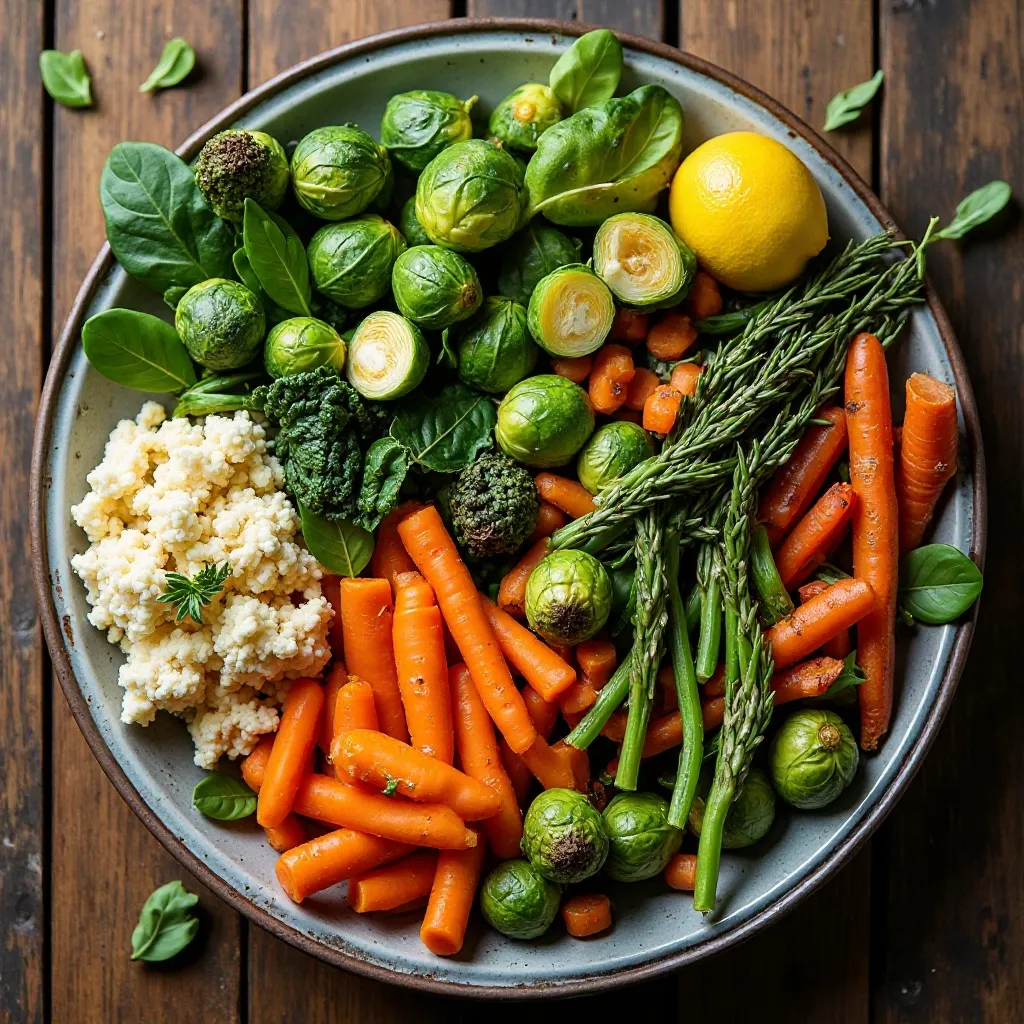
Step-by-Step Instructions
Recipe 1: Yam Dish for Thanksgiving
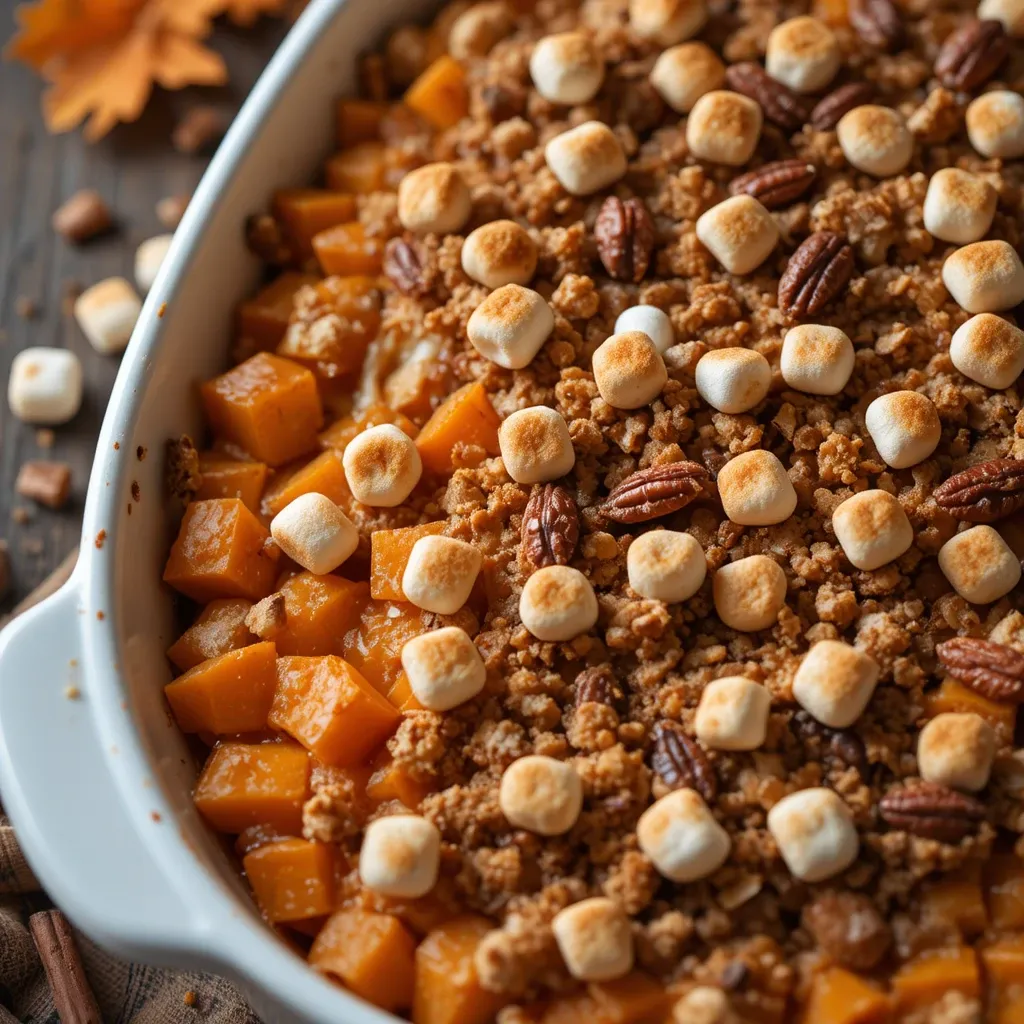
Key Ingredients for Yam Dish (Thanksgiving)
Yam Base:
- 4 lbs yams/sweet potatoes (6–7 medium)
- 1/2 cup melted butter
- 3/4 cup packed brown sugar
- 1/4 cup heavy cream or milk
- 2 large eggs, beaten
- 1 tsp vanilla
- 1 tsp cinnamon
- 1/2 tsp nutmeg
- 1/4 tsp ginger
- 1/2 tsp salt
Pecan Streusel:
- 1 cup chopped pecans
- 1/2 cup flour
- 1/2 cup brown sugar
- 1/3 cup melted butter
- 1/4 tsp cinnamon
Marshmallow Topping (Optional):
- 3 cups mini marshmallows (or 20–25 large)
Step-by-Step Instructions
Step 1: Bake the Yams
Preheat oven to 400°F. Wash and pierce yams; bake 45–60 minutes until soft. Cool slightly.
Step 2: Scoop & Mash
Cut yams open, scoop flesh into a bowl, and mash until mostly smooth (a few small lumps are fine).
Step 3: Mix the Filling
Lower oven to 350°F. Add butter, brown sugar, cream, eggs, vanilla, cinnamon, nutmeg, ginger, and salt. Mix until creamy.
Step 4: Add to Baking Dish
Grease a 9×13 dish and spread the mixture evenly.
Step 5: Add Topping
For streusel: Mix pecans, flour, sugar, butter, and cinnamon; sprinkle over the yams.
For marshmallows: Skip the topping for now—you’ll add them later.
Step 6: Bake
- Streusel version: Bake 35–40 minutes until golden and bubbling.
- Marshmallow version: Bake yams alone for 30 minutes, add marshmallows, then bake 10–15 minutes until toasted.
Step 7: Serve
Let rest 10 minutes before serving so it sets. Serve warm with your Thanksgiving spread.
Recipe 2: green bean side dish for thanksgiving
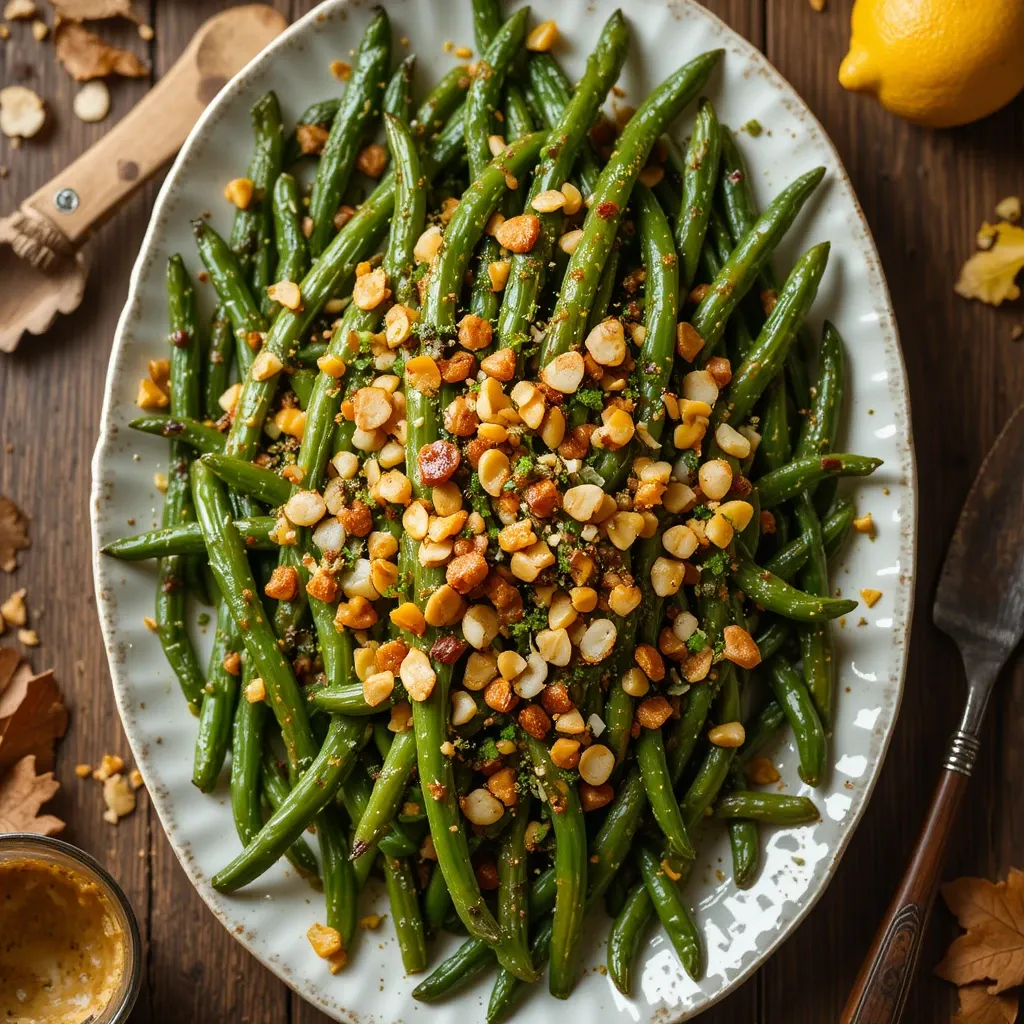
Key Ingredients for Green Bean Side Dish (Thanksgiving)
Green Beans:
- 2 lbs fresh green beans, trimmed
- 6 cups water
- 2 tbsp salt
- 4 cups ice water
Garlic Butter Sauce:
- 4 tbsp unsalted butter
- 4 garlic cloves, minced
- 1/2 tsp salt
- 1/4 tsp black pepper
- 1/4 tsp red pepper flakes (optional)
- 2 tbsp lemon juice
Topping:
- 1/2 cup toasted sliced almonds or 1 cup crispy fried onions
- 2 tbsp chopped parsley
- Zest of 1 lemon
Step-by-Step Instructions
Step 1: Prep Green Beans
Rinse and trim green beans. Pat dry.
Step 2: Blanch
Bring 6 cups salted water to a boil. Prepare an ice bath. Boil beans for 3–4 minutes until bright green and crisp-tender.
Step 3: Ice Bath
Transfer beans to ice water for 2–3 minutes. Drain and dry well.
Step 4: Make Garlic Butter
Melt butter in a skillet over medium heat. Add garlic and sauté 1 minute until fragrant (don’t brown).
Step 5: Sauté Beans
Add beans to the skillet and toss to coat. Season with salt, pepper, and optional red pepper flakes. Cook 3–4 minutes.
Step 6: Add Lemon
Remove from heat and add lemon juice. Toss to combine.
Step 7: Finish & Serve
Transfer to serving platter. Top with toasted almonds or fried onions, parsley, and lemon zest. Serve hot.
Recipe 3: Thanksgiving Sweet Potato Side Dish
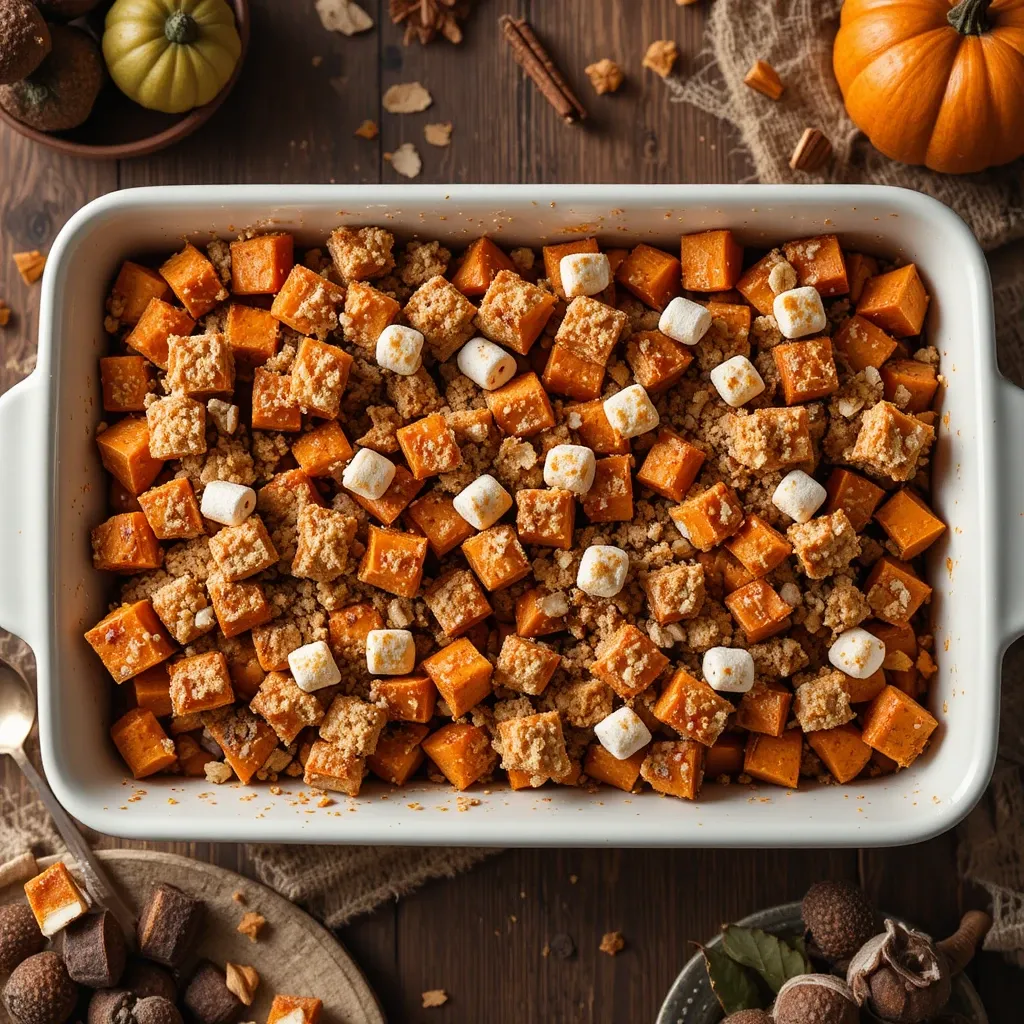
Key Ingredients for Thanksgiving Sweet Potato Side Dish
Sweet Potatoes:
- 4 lbs sweet potatoes, peeled & cubed (1-inch)
- 3 tbsp melted butter
- 3 tbsp pure maple syrup
- 1 tsp cinnamon
- 1/2 tsp nutmeg
- 1/4 tsp ginger
- 1/2 tsp kosher salt
- 1/4 tsp black pepper
Pecan Streusel:
- 1 cup chopped pecans
- 1/2 cup flour
- 1/2 cup brown sugar
- 1/2 cup cold butter, cubed
- 1/4 tsp salt
- 1/2 tsp cinnamon
Optional:
- 2 cups mini marshmallows
- 1 tbsp orange zest
- 2 tbsp bourbon
Step-by-Step Instructions
Step 1: Prep the Sweet Potatoes
Preheat oven to 400°F. Wash, peel, and cut potatoes into 1-inch cubes.
Step 2: Season
Mix butter, maple syrup, cinnamon, nutmeg, ginger, salt, and pepper. Toss sweet potato cubes until coated.
Step 3: Add to Baking Dish
Grease a 9×13 dish and spread potatoes in an even layer.
Step 4: First Roast
Roast 20 minutes. Stir to ensure even cooking.
Step 5: Make Streusel
Mix pecans, flour, brown sugar, salt, and cinnamon. Cut in the cold butter until the mixture forms coarse crumbs.
Step 6: Add Topping
Sprinkle streusel evenly over roasted potatoes.
Step 7: Final Bake
Bake another 15–20 minutes until potatoes are tender and topping is golden.
Step 8: Rest & Serve
Let rest 5 minutes. If using marshmallows, add during last 5 minutes of baking and broil 1–2 minutes to toast.
Recipe 4: roasted vegetables for thanksgiving
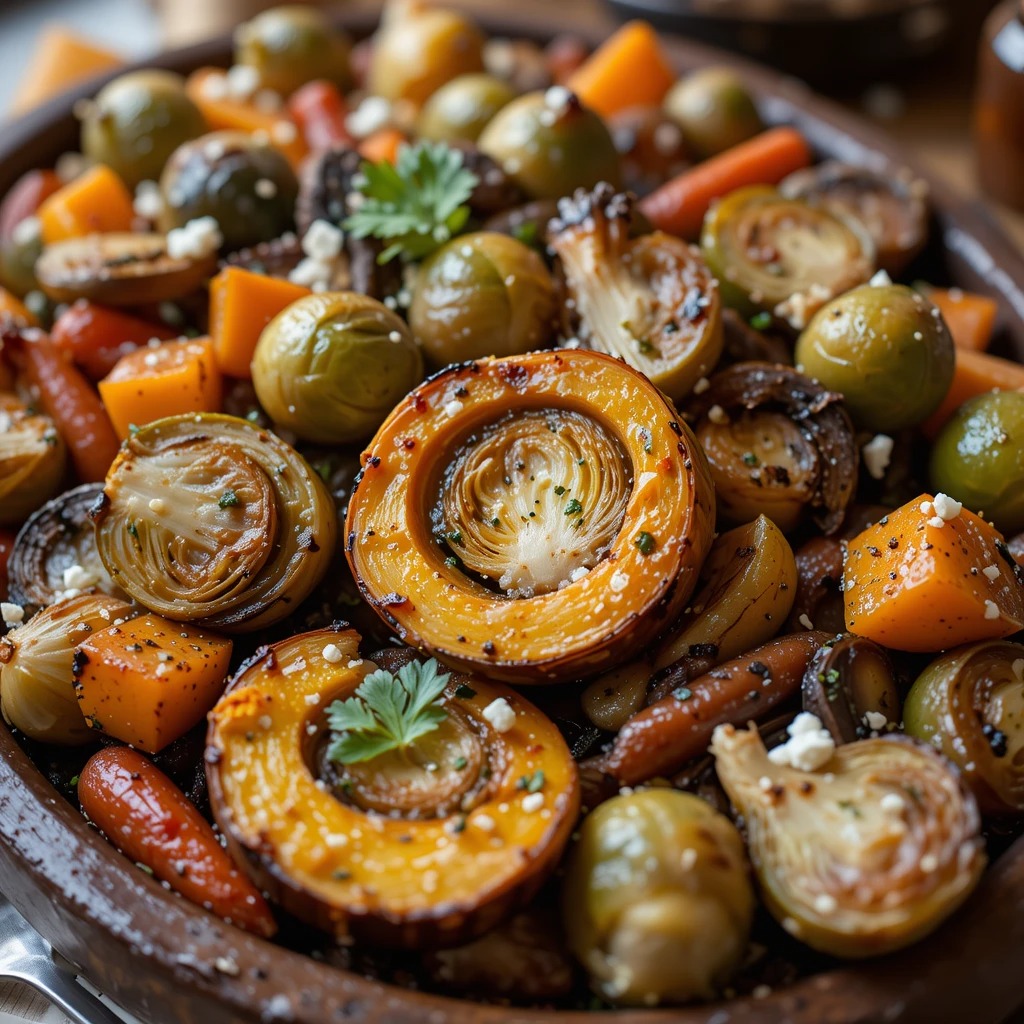
Key Ingredients for Roasted Vegetables (Thanksgiving)
Vegetables:
- 2 lbs butternut squash, peeled & cubed
- 1 lb Brussels sprouts, halved
- 3 large carrots, chopped (1-inch)
- 1 red onion, cut into wedges
- 8 oz cremini mushrooms, quartered
- 1 red bell pepper, chopped
Seasonings:
- 1/4 cup olive oil
- 3 garlic cloves, minced
- 2 tbsp fresh rosemary
- 2 tbsp fresh thyme
- 1 tsp sea salt
- 1/2 tsp black pepper
- 1/2 tsp smoked paprika (optional)
Finishing Options:
- Balsamic glaze
- Feta or goat cheese
- Toasted pecans
- Fresh parsley
Step-by-Step Instructions
Step 1: Preheat
Heat oven to 425°F (220°C). Line two baking sheets so the veggies don’t overcrowd.
Step 2: Prep Veggies
Cube squash, trim and halve Brussels sprouts, chop carrots, cut onion into wedges, quarter mushrooms, and chop bell pepper.
Step 3: Season
Add all vegetables to a large bowl. Toss with olive oil, garlic, rosemary, thyme, salt, pepper, and optional smoked paprika.
Step 4: Arrange
Spread vegetables in a single layer across the two baking sheets. Leave space between pieces for proper roasting.
Step 5: Roast
Roast 25–30 minutes, stirring halfway through. Rotate sheets if using two oven racks.
Step 6: Check Doneness
Veggies are ready when caramelized, golden at the edges, and fork-tender.
Step 7: Finish & Serve
Transfer to a platter. Add balsamic glaze, cheese, pecans, and parsley if desired. Serve hot.
Recipe 5: Parmesan Roasted Cauliflower
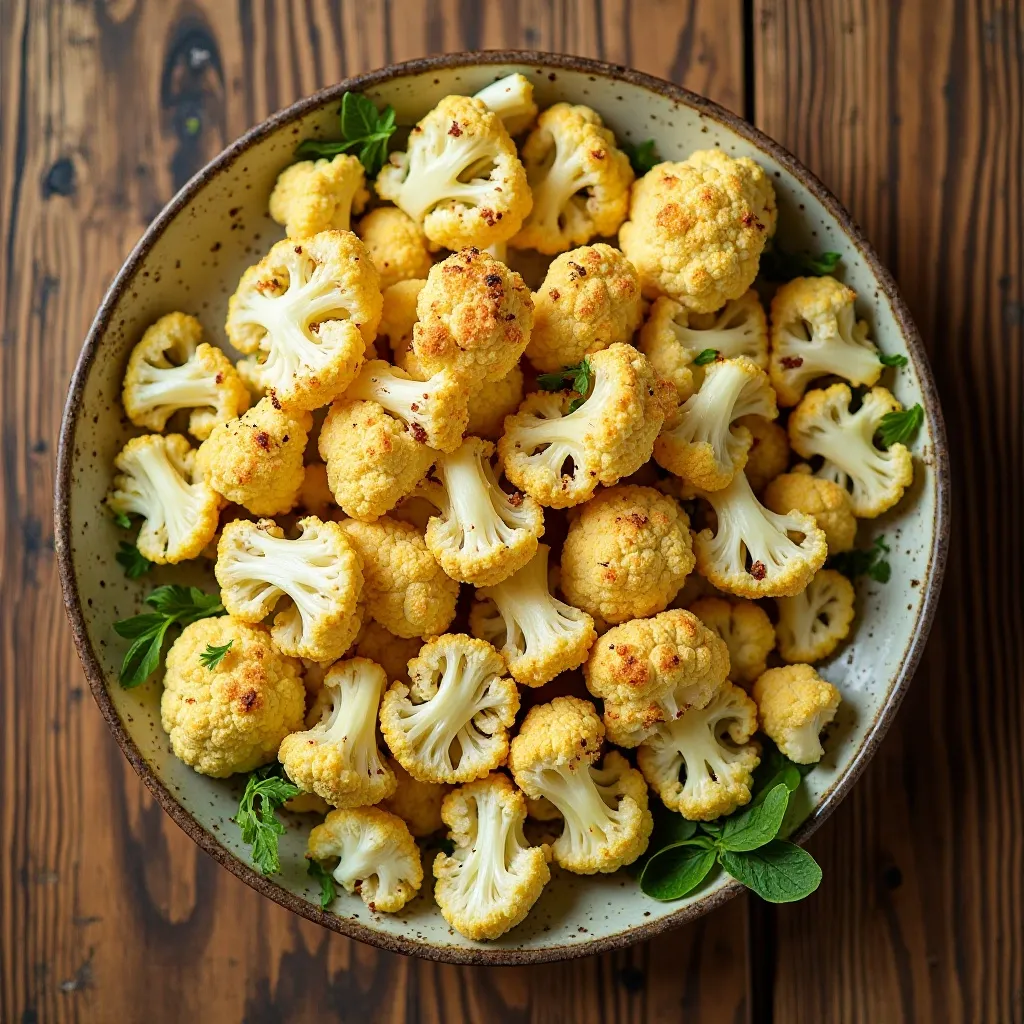
Heat your oven to 425°F and line a large baking sheet with foil or parchment paper for easy cleanup.
Cut the cauliflower into bite-sized florets, keeping them relatively uniform in size. Don’t discard the tender inner leaves—they become wonderfully crispy when roasted.
In a large mixing bowl, toss the cauliflower florets with 3 tablespoons olive oil, 4 cloves minced garlic, 1 teaspoon Italian seasoning, 1/2 teaspoon sea salt, and 1/4 teaspoon black pepper.
Spread the cauliflower on your prepared baking sheet in a single layer. Make sure there’s space between florets for proper air circulation and even browning.
Roast for 20-25 minutes until golden brown and tender, stirring once halfway through. The cauliflower should have crispy, caramelized edges with a tender interior.
Remove from the oven and immediately sprinkle with 1/3 cup freshly grated Parmesan cheese. The residual heat will melt the cheese perfectly. Finish with red pepper flakes if desired.
What to Serve Healthy Vegetable Side Dishes for Thanksgiving With
These healthy vegetable side dishes for Thanksgiving pair beautifully with traditional holiday mains. Serve them alongside herb-roasted turkey, glazed ham, or prime rib for a complete feast.
For a vegetarian Thanksgiving, combine 3-4 of these veggie sides with a hearty mushroom Wellington or stuffed acorn squash as the centerpiece. The variety of colors, textures, and flavors creates a satisfying meal.
Don’t forget complementary dishes like fluffy mashed potatoes, herbed stuffing, and tangy cranberry sauce. Balance rich, creamy sides with these lighter vegetable options for a well-rounded spread.
For beverages, pair these dishes with crisp white wine like Sauvignon Blanc, sparkling apple cider, or a light Pinot Noir that won’t overpower the delicate vegetable flavors.
Create a beautiful table by serving vegetables in rustic wooden bowls or white serving platters that make the vibrant colors pop. Garnish with fresh herbs for an elegant finishing touch.
Top Tips for Perfecting Healthy Vegetable Side Dishes for Thanksgiving
Temperature Is Everything
Always roast vegetables at high heat (400-450°F) for maximum caramelization. Lower temperatures steam rather than roast, resulting in soggy vegetables. Preheat your oven fully before adding vegetables.
If you’re cooking multiple dishes simultaneously, place vegetables on the middle rack where heat circulates best. Rotate pans halfway through for even browning.
Don’t Overcrowd the Pan
This is the most common mistake home cooks make. Vegetables need space to breathe and develop crispy edges. When pans are overcrowded, vegetables steam in their own moisture instead of roasting.
Use multiple baking sheets if necessary, or roast in batches. Leave at least 1/2 inch of space between vegetable pieces for optimal results.
Cut Uniformly for Even Cooking
Take time to cut vegetables into similar sizes. Inconsistent pieces mean some will burn while others remain undercooked. Use a ruler if needed until you develop an eye for uniform sizing.
For mixed vegetable dishes, consider density differences. Harder vegetables like carrots need smaller pieces than softer ones like zucchini to finish cooking simultaneously.
Season Generously
Vegetables can handle bold seasoning. Don’t be shy with salt—it draws out natural moisture and intensifies flavors. Season before cooking, not just at the end.
Layer flavors by using fresh herbs, citrus zest, quality olive oil, and finishing salts. Each element adds complexity without overwhelming the vegetable’s natural taste.
Timing and Make-Ahead Strategies
Most vegetables can be prepped 24 hours ahead. Cut, season, and store them covered in the refrigerator. Bring to room temperature before roasting for even cooking.
If reheating, use the oven rather than microwave to maintain texture. Spread on a baking sheet and reheat at 350°F for 8-10 minutes until warmed through.
Substitute Smartly
Out of fresh herbs? Use 1/3 the amount of dried herbs. Replace butter with olive oil for dairy-free options. Swap vegetables based on what’s fresh and available.
For nut allergies, replace almonds or pecans with roasted chickpeas or pumpkin seeds for similar crunch. Nutritional yeast provides cheesy flavor without dairy.
Storing and Reheating Tips
Refrigerator Storage
Store leftover healthy vegetable side dishes for Thanksgiving in airtight containers in the refrigerator for up to 4 days. Let vegetables cool completely before storing to prevent condensation.
Separate different vegetable dishes to maintain individual flavors. Glass containers work best as they don’t absorb odors and allow you to see contents easily.
For best results, store roasted vegetables and any sauces or glazes separately. Combine just before reheating to prevent sogginess.
Freezer Storage
Most roasted vegetables freeze well for up to 3 months. Cool completely, then spread on a baking sheet and freeze until solid. Transfer to freezer bags, removing as much air as possible.
Label containers with the dish name and date. Note that leafy greens and vegetables with high water content (like cucumber) don’t freeze well.
Thaw frozen vegetables overnight in the refrigerator before reheating for best texture.
Reheating Instructions
The oven method produces the best results for maintaining texture. Preheat oven to 350°F, spread vegetables on a baking sheet, and heat for 10-15 minutes until warmed through.
For quicker reheating, use a skillet over medium heat with a tablespoon of butter or oil. Stir frequently for 5-7 minutes until heated.
Microwave only as a last resort, using 50% power in 1-minute intervals to prevent overcooking. Add a teaspoon of water and cover to create steam.
Meal Prep Tips
Batch cook vegetables on Sunday for easy weeknight sides throughout the week. Roast different varieties using similar temperatures and timing.
Prepared vegetables make excellent additions to grain bowls, salads, and wraps. Store in portion-sized containers for grab-and-go convenience.
Common Mistakes to Avoid When Making Healthy Vegetable Side Dishes
Using Cold Vegetables
Taking vegetables straight from the refrigerator to the oven results in uneven cooking. Cold vegetables drop the oven temperature and increase cooking time.
Let prepped vegetables sit at room temperature for 15-20 minutes before roasting. This ensures even cooking from edge to center.
Not Drying Vegetables Properly
Excess moisture is the enemy of crispy, caramelized vegetables. After washing, dry thoroughly with clean kitchen towels or paper towels.
For vegetables like Brussels sprouts, pat completely dry after halving. Any water will create steam and prevent proper browning.
Adding Garlic Too Early
Garlic burns easily at high roasting temperatures, turning bitter and acrid. If your recipe calls for garlic, add it during the last 10 minutes of cooking.
Alternatively, toss roasted vegetables with raw minced garlic immediately after removing from the oven. The residual heat will cook it perfectly.
Over-Stirring
While recipes often suggest stirring or flipping vegetables, too much movement prevents caramelization. Let vegetables sit undisturbed for at least 15 minutes before the first flip.
Those beautiful brown spots only develop when vegetables maintain contact with the hot pan. Constant stirring keeps them moving too much.
Using Poor Quality Oil
Cheap vegetable oils can smoke at high temperatures and impart off-flavors. Invest in quality extra virgin olive oil or avocado oil for roasting.
Check the smoke point of your chosen oil. For high-heat roasting (425°F+), use oils with smoke points above 400°F.
Forgetting Acid for Balance
Many home cooks forget the importance of acidity. A squeeze of lemon juice, splash of balsamic vinegar, or sprinkle of vinegar-based hot sauce brightens flavors.
Add acidic elements after cooking to preserve their bright, fresh taste. The contrast cuts through richness and makes vegetables more craveable.
Frequently Asked Questions
Can I make healthy vegetable side dishes for Thanksgiving ahead of time?
Yes! Most vegetable sides can be prepped 24 hours ahead. Cut vegetables, toss with seasonings, and store covered in the refrigerator. For roasted dishes, you can roast them completely up to 2 days ahead and reheat in a 350°F oven for 10-15 minutes. Some dishes like green beans almondine are best made fresh, but you can blanch the beans a day ahead and finish cooking just before serving.
What are the healthiest vegetables to serve at Thanksgiving?
The healthiest options include Brussels sprouts (rich in vitamin K and C), butternut squash (high in vitamin A and fiber), green beans (loaded with antioxidants), cauliflower (anti-inflammatory properties), and leafy greens like kale or spinach (packed with iron and calcium). Choose a variety of colors for maximum nutritional benefit—the rainbow approach ensures you’re getting diverse vitamins, minerals, and phytonutrients.
How do I keep vegetables from getting soggy?
The key is high heat, dry vegetables, and proper spacing. Always pat vegetables completely dry after washing. Roast at 400-450°F and avoid overcrowding the pan—vegetables need space for moisture to evaporate. Use parchment paper or lightly oiled pans, not foil which traps steam. Don’t cover vegetables while roasting, and flip only once halfway through cooking.
Can I use frozen vegetables for Thanksgiving sides?
While fresh is best for texture and flavor, high-quality frozen vegetables can work in a pinch. Choose flash-frozen options without added sauces. Thaw completely and pat very dry before cooking. Expect slightly different textures—frozen vegetables often contain more water. Reduce cooking time by 5-10 minutes as frozen vegetables are partially cooked during the blanching process before freezing.
What’s the best way to reheat vegetable side dishes?
The oven method preserves texture best. Preheat to 350°F, spread vegetables in a single layer on a baking sheet, and heat for 10-15 minutes. For quicker reheating, use a skillet with a bit of butter or oil over medium heat. Avoid the microwave when possible as it creates steam that makes vegetables mushy. If you must microwave, use 50% power and heat in short intervals.
How do I make vegetables more flavorful?
Layer flavors using quality olive oil, fresh herbs, aromatic vegetables like garlic and shallots, and finishing elements like lemon zest, toasted nuts, or flaky sea salt. Don’t undersalt—vegetables need generous seasoning. Caramelize through high-heat roasting to develop natural sweetness. Add umami with Parmesan, nutritional yeast, or a splash of balsamic vinegar. Toast spices before adding them to release their aromatic oils.
Are these vegetable sides kid-friendly?
Absolutely! The maple-roasted butternut squash and honey-glazed carrots appeal to kids who prefer sweeter flavors. Involve children in preparation—kids are more likely to eat vegetables they helped cook. Cut vegetables into fun shapes, serve with dips, or sprinkle with cheese for added appeal. Start with mild seasonings and gradually introduce new flavors. The crispy texture of roasted vegetables is often more appealing than steamed or boiled.
Can I make these recipes vegan or dairy-free?
Yes! Simply substitute butter with vegan butter, olive oil, or coconut oil. Replace Parmesan cheese with nutritional yeast for a cheesy flavor. Use maple syrup or agave instead of honey for vegan-friendly sweetness. All the roasting techniques and flavor combinations work perfectly with plant-based substitutions. Most of these recipes are naturally vegan or easily adapted.
Nutrition Information
| Nutrient | Brussels Sprouts (per serving) | Glazed Carrots (per serving) | Green Beans (per serving) | Butternut Squash (per serving) |
|---|---|---|---|---|
| Calories | 95 | 110 | 85 | 120 |
| Protein | 4g | 1g | 3g | 2g |
| Carbohydrates | 12g | 18g | 10g | 22g |
| Fiber | 4g | 3g | 4g | 4g |
| Fat | 5g | 4g | 5g | 4g |
| Vitamin A | 15% DV | 380% DV | 10% DV | 460% DV |
| Vitamin C | 125% DV | 12% DV | 15% DV | 45% DV |
| Calcium | 4% DV | 4% DV | 6% DV | 8% DV |
| Iron | 8% DV | 4% DV | 6% DV | 6% DV |
Note: Nutrition values are approximate and based on standard serving sizes (1 cup). Values may vary based on specific ingredients and preparation methods used.
Final Thoughts
These healthy vegetable side dishes for Thanksgiving prove that nutritious eating doesn’t mean sacrificing flavor or tradition. Each recipe celebrates seasonal produce at its peak, using simple techniques that enhance natural flavors without complicated preparations.
The beauty of these dishes lies in their versatility. Mix and match based on your family’s preferences, dietary needs, and what looks freshest at the market. Don’t be afraid to experiment with different herbs, spices, and finishing touches.
Remember that the best holiday meals bring people together. These vegetable sides do exactly that—they’re conversation starters, colorful additions to your table, and dishes that prove healthy food can be the most delicious food.
This Thanksgiving, let vegetables shine alongside traditional favorites. Your guests will appreciate the lighter, fresher options, and you’ll feel good knowing you’re serving nutrient-dense dishes that truly nourish.
Make these recipes your own, create new traditions, and enjoy the satisfaction of a beautiful, healthy Thanksgiving feast. Your table—and your body—will thank you!
Ready to start cooking? Pin your favorite recipes, gather your ingredients, and let’s make this Thanksgiving the healthiest and most delicious one yet!
